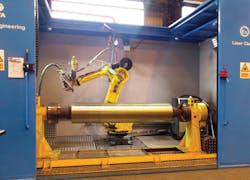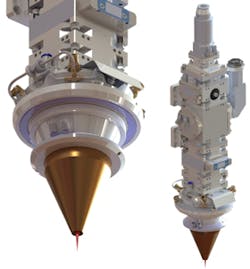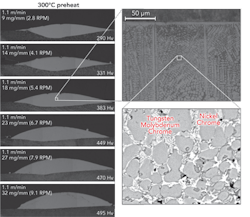Laser cladding increases critical lifetimes
Sam Lester, Justin Griffiths, John Cocker, Christian Staudenmaier, Gary Broadhead, and Nick Longfield
In the manufacture of steel strip work, components have to perform in exceptionally aggressive environments and withstand service at high temperatures in corrosive atmospheres under mechanical wear and frequent and heavy impact loading. Conventionally, components that are subject to high wear or corrosion have often been manufactured from rich chemistry steels or hardfaced using submerged arc clad martensitic stainless steels (MSSs) to increase their service life and therefore maximize line throughput by extending maintenance intervals without any sacrifice to product quality.
MSS-welded alloys generally have good wear and corrosion characteristics; however, they are not suitable for severe metal-on-metal abrasion, and they also lose their mechanical and corrosive properties at high temperatures. Arc-welded MSS alloys also suffer from weld sensitization in grain boundaries in the heat affected zones (HAZs) where chromium carbides are precipitated, leaving the surrounding areas depleted in chromium. These areas are therefore susceptible to localized corrosion.
Thermally sprayed coatings are also in widespread use throughout the steel industry because of their flexibility in the types of alloys and metal matrix composites (MMCs) that can be applied. However, their mechanically bonded interfaces have relatively low strength (unless post spray fusing is employed), limiting their practical use in an environment with very heavy impacts.
In 2009, a system was built in Port Talbot, South Wales, UK, in an attempt to develop laser cladding for coating critical works components to increase their service lifetime (FIGURE 1). In the rolling mills of the steel industry, different rolls of 0.3 to 3.5 meters in length are needed. Laser clad coatings have been proven to extend the lifetime of components by up to 6×.
Since the installation of the laser cladding system in Port Talbot, the process has been developed and numerous nickel cobalt and iron-based-material alloys have been assessed in terms of microstructure, mechanical properties, and wear and corrosion resistance. Detailed process development is required to tailor the coating properties for each application within the steel works.
The initial results from line trials were extremely encouraging: components that were laser clad obtained unprecedented wear and corrosion performance. As such, it was decided to build a production machine to cope with the anticipated demand.
Benefits of laser cladding
The laser cladding process is a method of hardfacing that can be used to increase the wear / corrosion / impact performance of metallic components. The process utilizes a precisely focused high-power laser beam to create a weld pool into which a metallic powder is applied. The powder is carried by a stream of inert shielding gas and is blown coaxially through the laser beam. The accurate nature of the laser beam allows fully dense cladding with minimal dilution (<5%), yet with a perfect metallurgical bond. Numerous coatings can be applied, the composition of which can be designed to combat the failure mechanisms associated with each component. FIGURE 2 shows the laser cladding head.
One of the major benefits associated with laser cladding is the ability to finely control the heat input, allowing deposition of a two phase MMC structure, namely:
- a matrix, typically a nickel-based alloy, for toughness, ductility, and impact resistance, while being wear resistant at elevated temperatures, and
- a reinforcing hard phase, typically a tungsten carbide, or titanium nitride / carbide, chromium carbide, etc.
The fine control of the heat input allows the matrix to be completely melted and alloyed to the substrate surface, while simultaneously the ceramic particles remain un-melted and are distributed evenly throughout the matrix, giving an extremely wear-resistant and impact-resistant coating. The ratio between the hard phase and matrix can be adjusted according to the service conditions, i.e., greater hard phase fraction for greater wear resistance and less hard phase for greater impact resistance.
Other benefits of the process include:
- minimal heat input and therefore a fast cooling rate with very fine microstructures and negligible distortion,
- the ability to achieve the desired coating chemistry in the first layer due to the minimal dilution,
- the ability to produce hardface coatings with exceptional surface finish (possibility of coating rolls and installing without machining), and
- a full metallurgical bond with the substrate, unlike all other low-heat-input spraying processes (HVOF, Cold Spray, D-Gun etc).
While there are numerous parameters involved in laser cladding, a particularly critical one is the powder mass flow rate. Once the optimum laser spot diameter, cladding speed, and laser power have been identified for a particular application, the powder mass flow rate can be used to control the clad thickness, hardness, and dilution as shown in FIGURE 3, where an increasing powder flow rate can be seen to effectively control the dilution.
Once the optimum parameters have been identified for the single-track bead-on-plate weld, mass area coverage is achieved by producing overlapped tracks. The amount of overlap then determines the coating thickness, which can range from 0.3 mm to 3.0 mm in a single pass.
To demonstrate and quantify the potential benefits of laser cladding versus conventional hardfacing techniques, a number of samples of both laser clad and submerged-arc clad were produced and wear tested by Tata Steel RD&T at Sheffield University, UK. Results of wear tests carried out at low and high temperatures were reproduced.
Production laser cladding facility
Machine tools capable of laser cladding can be purchased directly from suppliers in Europe and America. However, it was decided that a custom production laser cladding machine would be built by Tata Steel engineers. The system is based on a Laser Line fiber-coupled diode laser with a Precitec YC52 cladding head and a metallization mass flow controlled powder feeder. The system is controlled by a Fanuc robot with an additional 7th axis for rotating cylindrical parts up to 6 tons in weight and 3.5 m long.
The operation of the machine is controlled through a touch-screen HMI. The system was designed to operate in an autonomous manner, whereby the robot is capable of automatic programming. This is achieved by the incorporation of a distance measurement laser that determines geometry of the component, the start and stop locations, and also the laser head standoff distance. This ensures that the state-of-the-art process can be operated with very little training. Detailed monitoring ensures that the process is stable while an automatic stop and retract function prevents damage in the event of an unexpected interruption.
The laser cladding process has shown substantial benefits for increasing the critical lifetime of works components in the steel industry, and with the advent of high power diode laser systems and dedicated laser cladding nozzles, a robust cladding process is now far simpler to design and integrate for hardfacing applications. ✺
Sam Lester([email protected]) and Justin Griffiths are with Tata Steel; John Cocker is with Laser Trade; Christian Staudenmaier is with Precitec; Gary Broadhead is with Laser Line; and Dr. Nick Longfield is formerly with Tata Steel.
More Industrial Laser Solutions Current Issue Articles
More Industrial Laser Solutions Archives Issue Articles


